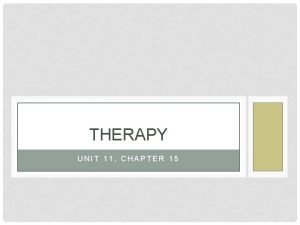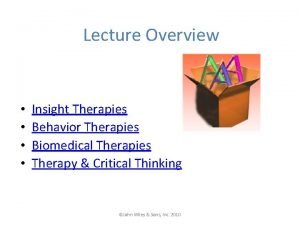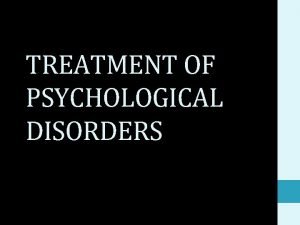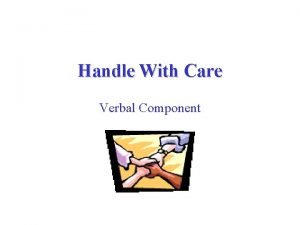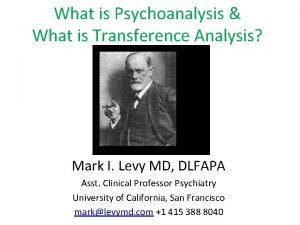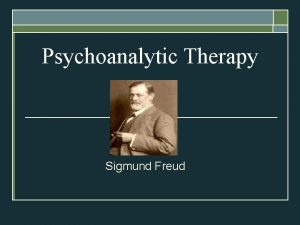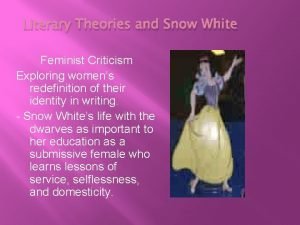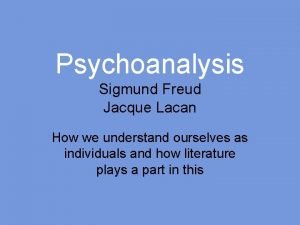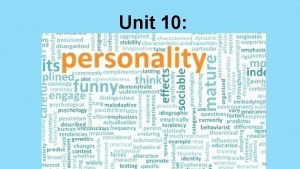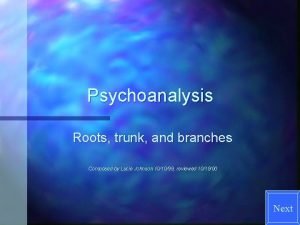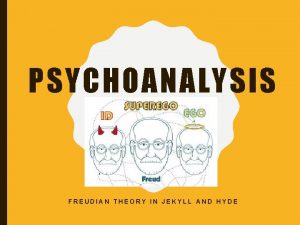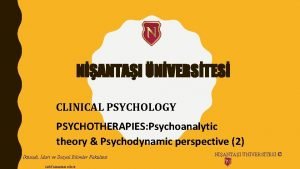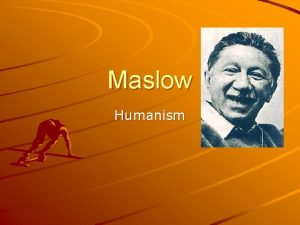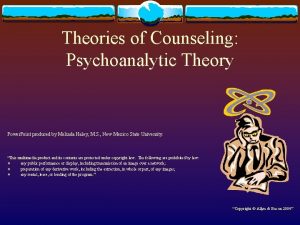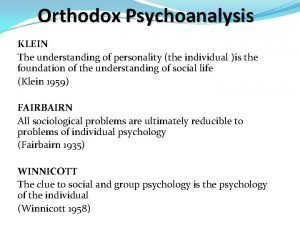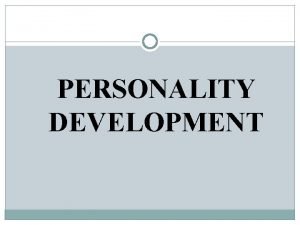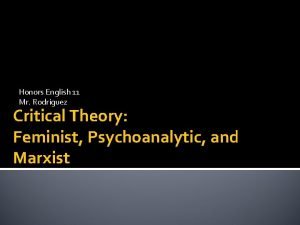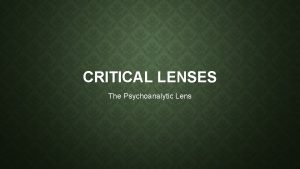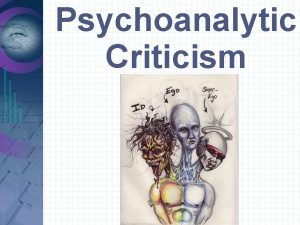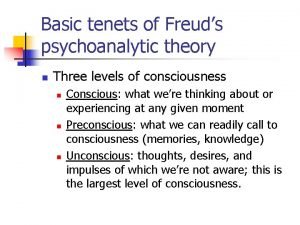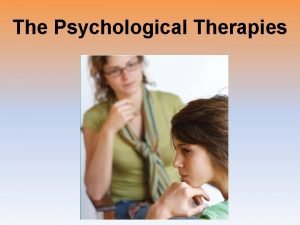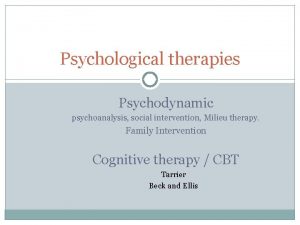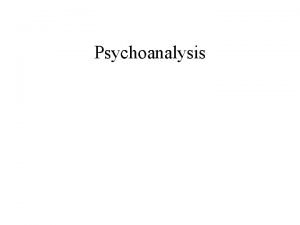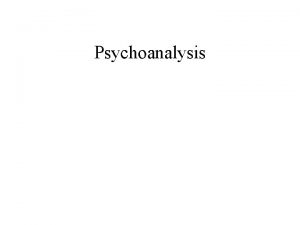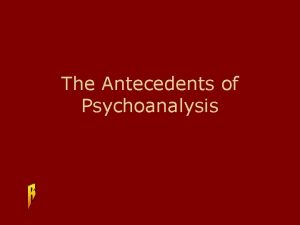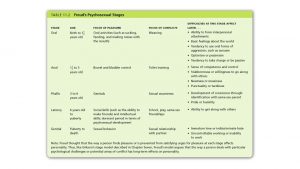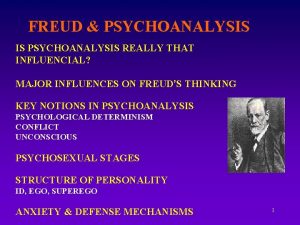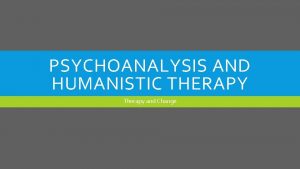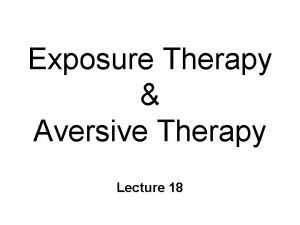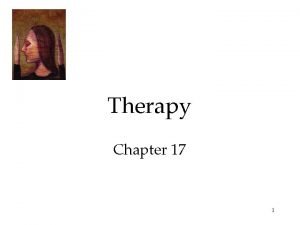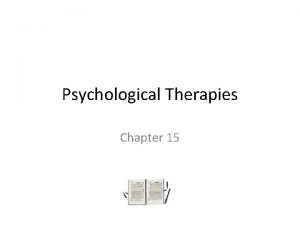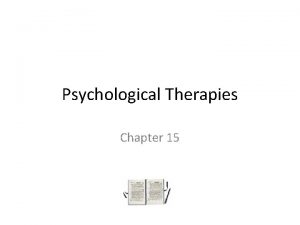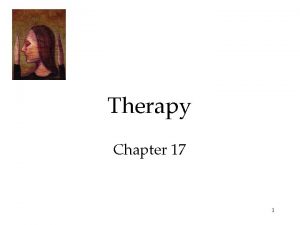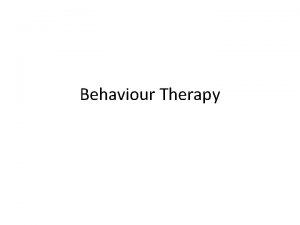Therapy Insight therapies Psychoanalysis Aim get at the






























- Slides: 30

Therapy

Insight therapies

Psychoanalysis • Aim – get at the root of the disorder or disturbed behavior – find the cause – – – Repression Resistance Free association Therapist interprets contradictions Years

Psychodynamic • • Face to face Shorter in term Therapist probes for information Interpersonal therapy – to gain insights into roots of behaviors but also suggest practical coping strategies

Humanistic

Humanistic • • • WE hold the power self-fulfillment Present and future Conscious not unconscious Carl Rogers (Rogerian psychology) – “clients” not “patients” – “growth” not “cure” – Active listening by therapist (echoing) – Empathy of therapist - more personal connection • Influenced by Maslow – hierarchy of needs

Behavior therapy • Focus on the assumption that the problem IS the behavior, not the underlying reasons for it • Aim: eliminate the problem behavior through conditioning techniques • Examples of Behavior Therapies – Aversive conditioning – Counter conditioning – Operant conditioning – Exposure and systematic desensitization • Phobias / addictive behaviors

Aversive conditioning • Often used for addictions or to stop troubling impulsive behavior • Tries to replace a positive response to a harmful stimulus with a negative response • Example – creating a taste aversion to alcohol or cigarettes by lacing with a nausea producing substance • Criticism: people are cognitively aware that the association is false and can override the association

Counter-conditioning • Example – Peter – fear of rabbits – counter conditioned by pairing rabbits with treats for Peter

Token Economy

Operant conditioning Therapy • Often used for children with self-abusing behaviors or mental disabilities or autism • Rewards desired behaviors and ignores or punishes undesired behaviors • Token economy – used / created by therapists in some situations to create intense system of concrete rewards – Positive behaviors rewarded with tokens that can be saved for treats , extra TV time, etc. – Think star charts for behavior • Criticisms – Subject to extinction when rewards stop (remember reward schedules) – Ethics of controlling other’s behavior

Exposure therapy & systematic desensitization • Progress to exposure in a real environment Has been used for phobias and obsessive compulsive disorders.


Cognitive behavioral therapy Aimed at mood, emotional or anxiety disorders • Emphasizes our distressed reactions are not produced by events / outside stimuli but at how we perceive and think about those events / stimuli Ex: a criticism on an essay could be the source of stress, anger or satisfaction that the student has gotten feedback on how to better their paper depending on the thinking of the student about the comment

Cognitions

REBT – Rational-Emotive Behavior Therapy – Albert Ellis "I absolutely MUST, under practically all conditions and at all times, perform well (or outstandingly well) and win the approval (or complete love) of significant others. If I fail in these important—and sacred—respects, that is awful and I am a bad, incompetent, unworthy person, who will probably always fail and deserves to suffer. " "Other people with whom I relate or associate, absolutely MUST, under practically all conditions and at all times, treat me nicely, considerately and fairly. Otherwise, it is terrible and they are rotten, bad, unworthy people who will always treat me badly and do not deserve a good life and should be severely punished for acting so abominably to me. " "The conditions under which I live absolutely MUST, at practically all times, be favorable, safe, hassle-free, and quickly and easily enjoyable, and if they are not that way it's awful and horrible and I can't bear it. I can't ever enjoy myself at all. My life is impossible and hardly worth living. " Holding this belief when faced with adversity tends to contribute to feelings of frustration and discomfort, intolerance, adversity tends to contribute to feelings of anxiety, panic, depression, despair, and self-pity, anger, depression, and to anger, rage, fury, and vindictiveness. worthlessness. behaviors such as procrastination, avoidance, and inaction.

Commonly held irrational assumptions • I should be loved by everyone – otherwise I must be doing something wrong! • I should be thoroughly competent at everything. • It is it catastrophic when things are not the way I want them to be. • I have no control over my happiness. • I need someone stronger than myself to be dependent on. • My past history greatly influences my present life. • There is a perfect solution to problems in my life, and it’s a disaster if I don’t find it.

Group therapy • Social context – many treated simultaneously • Allows people to get feedback from people with the same issues feeling that they aren’t alone or “crazy” • Allows families to effectively address relationship issues together and explore their roles with one another

Alternative therapies • Electroconvulsive (ECT) Psychosurgery • Therapeutic touch • EMDR – Eye Movement Desensitization & Reprocessing • Light Exposure

Electroconvulsive (ECT) – Today – anesthetized patients – Used to treat severe depression – 80% improvement rate – exact reasons unknown – May stimulate norepinephrine production in brain and boost mood

Psychosurgery • Drastic – involves removing or destroying (lesioning) brain tissue • Corpus callosum removal for severe epilepsy • Lobotomy for severe emotional disorders – rarely used today – severs connections to frontal lobe from emotive part of lower brain – (disconnects emotion from thought)

• Therapeutic touch – based on “energy center conduction” – no known benefit • Eye Movement Desensitization & Reprocessing (EMDR) – Involves remembering / reviewing traumatic events while stimulating eyes to move rapidly – Possible benefits, unknown if placebo or due to review of trauma in a safe environment or actual eye movements

• Light exposure – SAD • Morning light is found to boost melatonin levels and improved mood

Drugs • Antipsychotics – Thorozine / clorazil - reduce irrelevant stimuli (can relieve auditory hallucinations) • May produce tardive dyskinesia (pursing of lips or eye blinking, lip smacking etc. ) in prolonged use

Anti-anxiety • Ex: xanax / atavan, valium – depress CNS activity by increasing GABA • to relaxation • SSRI’s are also common for anxiety

Anti-depressants • Selective Serotonin Reuptake Inhibitors (SSRI’s) – Increase ability of norepinephrine and serotonin to bind to receptors – Ex: Prozac, Zoloft, Paxil – block reuptake of serotonin in the synapse • Lithium – salt compound – used to balance moods in bipolar disorder by interfering with the firing of neurons.

Antipsychotic Drugs Classical antipsychotic - Thorazine: Removes a positive symptoms of schizophrenia - agitation, delusions, and hallucinations. Atypical antipsychotics - Clozaril: Removes negative symptoms of schizophrenia - apathy, jumbled thoughts, concentration difficulties 27

Atypical Antipsychotic Clozapine (Clozaril) blocks receptors for dopamine and serotonin to remove the negative symptoms of schizophrenia. 28

Mood-Stabilizing Medications Lithium Carbonate, a common salt, has been used to stabilize manic episodes in bipolar disorders. It moderates the levels of norepinephrine and glutamate neurotransmitters. 29

The Relative Effectiveness of Different Therapies Which psychotherapy would be most effective for treating a particular problem? Disorder Therapy Depression Behavior, Cognition, Interpersonal Anxiety Cognition, Exposure, Stress Inoculation Bulimia Cognitive-behavior Phobia Behavior Bed Wetting Behavior Modification 30
 Get on get off get into get out of
Get on get off get into get out of Systematic desensitization therapy
Systematic desensitization therapy Insight therapies
Insight therapies Insight therapies involve verbal interactions
Insight therapies involve verbal interactions Psychoanalytic therapy is to as humanistic therapy is to
Psychoanalytic therapy is to as humanistic therapy is to Psychoanalytic therapy is to as humanistic therapy is to
Psychoanalytic therapy is to as humanistic therapy is to One direction one thing lyrics
One direction one thing lyrics Psychoanalytic theory
Psychoanalytic theory Types of psychoanalytic theory
Types of psychoanalytic theory Transference meaning
Transference meaning Mark of transference
Mark of transference Psychoanalytic method
Psychoanalytic method Eros freud
Eros freud Feminist snow white
Feminist snow white Theory of psychoanalysis
Theory of psychoanalysis Psychoanalysis
Psychoanalysis Branches of psychoanalysis
Branches of psychoanalysis Jekyll and hyde psychoanalysis
Jekyll and hyde psychoanalysis Transference psychoanalysis
Transference psychoanalysis Humanist maslow
Humanist maslow Sigmund freud psychodynamic theory
Sigmund freud psychodynamic theory Orthodox psychoanalysis
Orthodox psychoanalysis Freudian personality theory
Freudian personality theory Psychoanalysis theory
Psychoanalysis theory Psychological lens examples
Psychological lens examples Definition of psychoanalytic criticism
Definition of psychoanalytic criticism Tenets of psychoanalysis
Tenets of psychoanalysis Bioness bits cost
Bioness bits cost Germer
Germer Get up get moving quiz
Get up get moving quiz Get up get moving quiz
Get up get moving quiz

